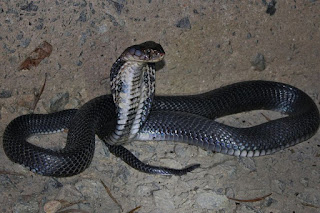The Chinese cobra (Naja atra), also called Taiwan cobra, is a species of cobra in the Elapidae family, found mostly in southern China and a couple of neighboring nations and islands. It is one of the most prevalent venomous snakes in mainland China and Taiwan, which has caused snakebite incidents to humans.
This medium-sized snake is usually 1.2 to 1.5 metres (3.9 to 4.9 ft) long, but they can grow to a maximum length of 2 metres (6.6 ft) though this is rare.
The hood mark shape is variable from spectacle, mask to horseshoe or O- shape and is often linked to light throat area on at least one side. The throat area is clearly defined light which is usually with a pair of clearly defined lateral spots.
The Chinese cobra is iridescent black with a number of distant transversal double lines of a yellow colour. The abdominal surface is pearl or slaty coloured. The dorsal color of the Chinese cobra is usually brown, grey or black, with or without narrow, light transverse lines at irregular intervals which are especially prominent in juveniles. The upper head is usually the same color as the tail and dorsal part of the body, while the sides of the head are lighter in colour. Specimens with other colors on their dorsal surface, such as white, yellow or brown do occur. There may be irregular or scattered crosslines of white to light gray along the upper body and a spectacle marking on the hood. The ventral head and neck are white to light gray or light orange in colour. There is some variation in the colour of the ventral body and tail: it could be white to gray, dark gray mottled with white, or blackish. The populations in different geographic regions of Taiwan show a different composition of ventral colouration: the eastern population is all blackish (100%), the central and southern populations are mostly white to gray (both 80%), and the proportions of blackish and white-gray phases in the northern population are 60% and 30%, respectively.
The head on this species is broad, slightly triangular in shape and is slightly distinct from the neck. The dorsal scales are smooth and glossy, while the dorsolateral scales are strongly oblique. This is a heavy bodied snake, the body is slightly flattened, and may be significantly flattened when threatened, and it has a short tail. The nostrils of this species are large and prominent. The eyes are medium-sized and the iris is a dark dirty yellow dappled with gray-black or blue-black and the pupil is round and jet black.
Like other elapids, this is a proteroglyphous snake with fangs that are permanently erect and are located at the anterior of the upper jaw.
23-29 scale rows around hood (usually 25-27); 19-21 just ahead mid-body (usually 21); ventral scales 161-180 (usually 171 in males, 173 in females); subcaudal scales 37-51 pairs (usually 48 in males, 46 in females). Anal scale is entire.
The Chinese cobra is sometimes confused with the Monocled cobra (Naja kaouthia). But it can be easily distinguished by virtue of having lower ventral and subcaudal scale counts, particularly when sex is taken into account.






